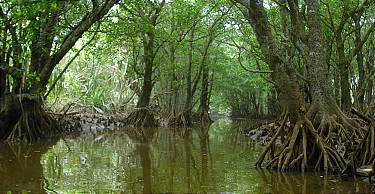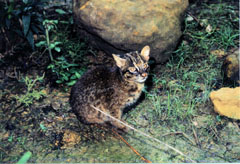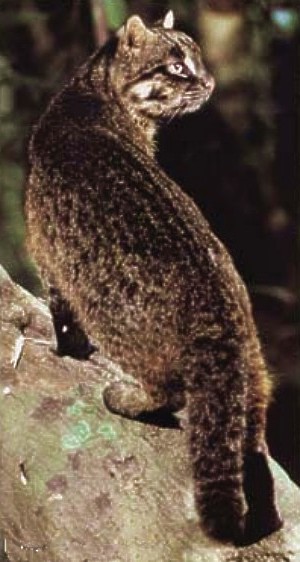
February 6, 2009
“The Yamapikarya – Japan’s Mystery Cat” Part 1
Guest Blog by Brent Swancer
Is there a large mystery cat roaming the jungles of Japan’s Iriomote Island?

Iriomote island lies about 200 kilometers east of Taiwan, 1,240 miles Southwest of Tokyo, and is part of Japan’s Okinawa archipelago of islands.

At approximately 289 square kilometers (113 square miles) in area, Iriomote is the largest island in the Yeayama Shoto island chain, and is the second largest island in all of Okinawa. Iriomote is one of the great wild areas left in Japan, with 90% of its mountainous land made up of lush, pristine subtropical jungle and mangrove swamps.

Much of this land falls within the Iriomote National Park or is protected state land, with its plants and animals protected by a district forestry service.

This beautiful, untouched wilderness is home to many rare and unique animals and plants, some found nowhere else on Earth, and due to this biological diversity, Iriomote island has sometimes been called “The Galapagos of East Asia.”

Iriomote is already home to one known species of wildcat, known as the Iriomote wildcat or Iriomote cat (Prionailurus iriomotensis), and often called the “Yamaneko,” or “mountain cat” in Japanese. The Iriomote wildcat is endemic to the island, meaning it is found no where else in the world. This cat is so elusive that it was not discovered until 1967, and there are many people who have lived on the island their entire lives who have never seen one or indeed even know it exists.

The Iriomote wildcat is approximately the size of a domestic housecat, around 50 cm long and weighing from 3 to 8 kg (6-18 lbs). It is dark or grayish brown in color, with lines on the neck that end at the shoulders and longitudinal rows of black spots that merge into lines on its flanks. The Iriomote cat is thought to be related to Asian leopard cats (Prionailurus bengalensis) native to Southeast Asia, although its exact taxonomy within this group is often disputed. It is one of the most primitive forms of extant cat in the world, and with only around 100 or fewer individuals remaining, it is also one of the rarest.
While the Iriomote wildcat is no longer a cryptid, there have long been stories and rumors of another type of larger cat living deep in the remote, mist shrouded jungles of the island.
Iriomote was originally not considered fit for human habitation due to the rampant malaria once found there. The island had primarily an agricultural role, being used for rice farming due to its abundant water, and human settlement on Iriomote island didn’t begin in earnest until after World War II, with the eradication of malaria.
At the time of this population growth, sightings began to surface of large mystery cats in the wilderness. This mystery cat, now known as the “Yamapikarya,” was first known through reports by wild boar hunters, who are known to venture far off the beaten trails. These hunters told of a large cat in the mountains and swamps of the island’s interior, often described as being similar to a leopard or jaguar.
The Yamapikariya is described as being between 1 and 1.3 meters in length, or twice the size of the Iriomote wildcat, and stoutly built. Its coat is said to be yellow, dark yellow, or orangish in color, with large, black spots. The tail of the cat is remarkably long, an interesting detail that is often mentioned in reports of the animal.
Since the first reports by these hunters, there have been at least 47 eyewitness reports on record, possibly even more. Sightings of the cats reached their pinnacle in the 50s and 60s, after which reported encounters with the cats diminished considerably, most probably due to the cats moving deeper into the uninhabited areas of the island to avoid humans and increasing development in the coastal areas. In recent years, sightings have dropped off almost completely, yet some intriguing and often fairly credible recent sightings still pop up from time to time.
One such sighting occurred in the summer of 1978, when a hunter reported seeing a large cat lounging up in a tree. The eyewitness described the cat as having spots that were “oddly shaped,” although exactly how they were odd is not mentioned, and a long tail that hung down “like a vine.” After observing the cat for several minutes, the hunter reports that the cat seemed to suddenly realize it was not alone, after which it bounded down the tree and into the forest with what he says was extraordinary speed and agility. The cat did not make any sounds.
In 2003, a Mr. Shimabukuro, who runs a fishing boat on the island, spotted a Yamapikariya while he was in the mountains setting wild boar traps. According to his report, he was setting the traps and found himself walking along a gravelly open clearing. After walking along this clearing for around 100 meters, he was surprised when a large, spotted cat, estimated at slightly over a meter long, suddenly leapt down from the top of a large boulder, landing right in front of him before disappearing into the underbrush. As the cat retreated, the man noticed that it was spotted, and had a remarkably long tail. He recalled being startled, and claims to have never seen anything like it on the island.
In September of 2007, the cat was seen by a Mr. Aiyoshi, who is a professor at Shimane University in Japan. According to his report, the professor was sitting on a beach fishing for a research project when a dark shape appeared from the thick forest just 2.5 meters from where he sat. His first bewildered reaction upon realizing an animal was there was that a wild boar had crept out of the trees, but it became quickly apparent this was a large cat which he describes as being a meter in length, with a very long tail and black spots, and looking similar to a leopard. The professor reported how the cat stared right at him before calmly slinking into the shadowy forest once more.
What do reports like this mean? The only two types of cat known to exist on the island are the endemic Iriomote wildcat, and introduced house cats, yet it seems fairly obvious from physical descriptions of the mystery animal that what is being seen is neither of these. The Yamapikariya is described as being much larger than either of these cats, twice their size or more, and the animal’s coloring does not match up either. The Iriomote wildcat also does not have a particularly long tail, which may seem like a minor point, but is a feature that is often mentioned in Yamapikarya reports. The long tail is therefore apparently a striking enough attribute of the animal to catch people’s attention and make it noteworthy. There are dogs on the island, but again the reports do not seem to be describing a typical domestic dog either. It also seems that there were likely few, if any, domestic cats or dogs on the island during the time when the first sightings of the Yamapikarya were being reported. In addition, many eyewitnesses of the mystery cat have been hunters, who would probably be quite familiar with the animals of the area.
Whatever is being seen, it seems questionable that the reports can be attributed to misidentifications of dogs or known cats on the island. It seems apparent that the mystery cat is likely something else. But what?
Please stay tuned for Part II on the Yamapikarya, where we will look at the plausibility of the island harboring a cryptid as well as some possibilities on what the animal might be.
More to come!
End of Part 1.
About Loren Coleman
Loren Coleman is one of the world’s leading cryptozoologists, some say “the” leading living cryptozoologist. Certainly, he is acknowledged as the current living American researcher and writer who has most popularized cryptozoology in the late 20th and early 21st centuries.
Starting his fieldwork and investigations in 1960, after traveling and trekking extensively in pursuit of cryptozoological mysteries, Coleman began writing to share his experiences in 1969. An honorary member of Ivan T. Sanderson’s Society for the Investigation of the Unexplained in the 1970s, Coleman has been bestowed with similar honorary memberships of the North Idaho College Cryptozoology Club in 1983, and in subsequent years, that of the British Columbia Scientific Cryptozoology Club, CryptoSafari International, and other international organizations. He was also a Life Member and Benefactor of the International Society of Cryptozoology (now-defunct).
Loren Coleman’s daily blog, as a member of the Cryptomundo Team, served as an ongoing avenue of communication for the ever-growing body of cryptozoo news from 2005 through 2013. He returned as an infrequent contributor beginning Halloween week of 2015.
Coleman is the founder in 2003, and current director of the International Cryptozoology Museum in Portland, Maine.
Filed under Cryptomundo Exclusive, CryptoZoo News, Guest Blog, Mystery Cats